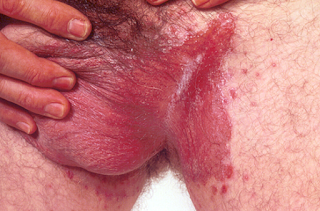Coccidioides immitis (Southwest USA)
- Located in desert soil
- Characteristic structures
- In the environment: Arthroconidia
- In the body: Sphereules are pathognomonic
Blastomyces dermatitidis (north central and southeast USA)
- Associated with water
Lymphocutaneous Sporotrichosis
Mucocutaneous mycoses: candida and dermatophytosis (get inflammatory response)
- Candida albicans
- Primary cutaneous candidiasis
- Mucocutaneous candidiasis
Candidiasis
- Wide range of infections
- Candida albicans is the most virulent species
- Candida spp. are common organisms of the skin, GI and UG tracts.
- Candidiasis is a disease of compromised hosts.
Mucocutaneous (T CELL IMPAIRMENT)
- Systems affected:
- GI tract, skin, vagina
- Onychomycosis
- Keratitis
- Symptoms: Odynophagia, stridor, etc.
- Diagnosis: white pseudomembranous plaques with hyphae, pseudohyphae, and budding yeast.
- Groups at risk
- HIV patients
- Diabetics
- Pregnancy
- Age
- Antibiotics
- Steroids
Chronic mucocutaneous candidiasis – autoimmune polyendocrinopathy candidosis ectodermal dystrophy
- Inherited disorder of CMI to candida along with polyendocrinopathies
- Intractable candida infection of the mucocutaneous areas
- Concurrent adrenal insufficiency and hypoparathyroidism
- Type I diabetes
- Hypothryroidism
- Hypogonadism
- Ectodermal dystrophy
Deeply invasive candidiasis (think CANCER)
- Systems affected/ symptoms and signs:
- Candidemia
- Endocarditis – organism is sticky
- Hepatosplenomegaly
- Acute, shocklike syndrome
- Renal dysfunction
At risk groups:
- Altered barriers
- Neutropenia
- Transplant
- Hemodialysis
- Pathogenesis
- Adherence and colonization
- Penetration through mucosal barriers and angioinvasions/access through catheters
- Hematogenous spread
- Replication yields necrosis +/- abscess with budding yeast and hyphae
- Look at the fundus! Candida goes to the eyes!
Virulence factors of Candida
- Surface receptors
- Cell wall is an immune modulator
- Hydrolytic enzymes – e.g. acid protease, phospholipase
- Host mimicry – e.g. C3D receptor
- Dimorphism – makes it hardy!
- Germ tube + species.
Superficial:
- Fungus confined to the stratum corneum or distal portions of hair
- Tinea versicolor: Malassezia furfur
- Pigmentation changes due to fungal effect on melanocytes
- Can cause folliculitis
- Can cause fungemia in neonates with indwelling vascular catheters receiving total nutrition with lipids.
- Malassezia furfur is a lipophilic yeast and it requires fatty acids to grow.

.png)
.png)
.png)


.png)




.png)
.png)
.png)






.png)




0 comments:
Post a Comment